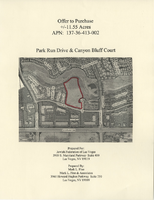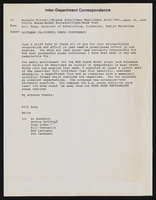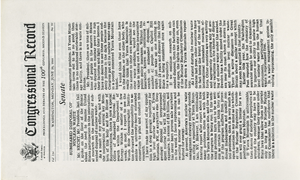Search the Special Collections and Archives Portal
Search Results
Linda Hartley oral history interview
Identifier
Abstract
Oral history interview with Linda Hartley conducted by Pauline Marchese on March 10, 1978 for the Ralph Roske Oral History Project on Early Las Vegas. During the interview, the two discuss Hartley’s personal history, such as schools that she had attended and her recollection of local recreational activities. The two go on to talk about changes in crime, the environment, and briefly discuss a variety of issues at the time, including: segregated schools, prostitution, and effects of the Nevada Test Site.
Archival Collection

Warren V. Turner oral history interview
Identifier
Abstract
Oral history interview with Warren V. Turner conducted by Arnol D. Wilks on March 10, 1975 for the Ralph Roske Oral History Project on Early Las Vegas. In this interview, Turner discusses arriving to Boulder City, Nevada in 1948 while working for the Bureau of Reclamation. Turner recalls aboveground testing of atomic weapons at the Nevada Test Site and describes the magnitude of the blasts. Turner also describes the development of Las Vegas, Nevada, specifically the growth in population, casinos, and hotels. Turner later discusses the natural environment surrounding the Las Vegas valley.
Archival Collection
Flora Jones oral history interview
Identifier
Abstract
Oral history interview with Flora Jones conducted by Claytee D. White on July 19, 2007 for the UNLV @ 50 Oral History Project. In this interview Flora Jones discusses getting a job at the University of Nevada, Las Vegas (UNLV), in the admissions office. She then discusses her work environment, the UNLV Campus, downtown Las Vegas, Nevada, and the students she worked with. She also shares her opinions of many facets of UNLV today, including the new student union and recreational buildings as well as UNLV becoming a Research I institution.
Archival Collection

Document from Mark L. Fine & Associates offer to purchase land from the Jewish Federation of Las Vegas, 2005
Date
Archival Collection
Description
Proposal from Mark L. Fine and Associates to purchase land from the Jewish Federation of Las Vegas at the northwest corner Park Run Drive and Canyon Bluff Court in Summerlin.
Text

Photographs of Venetian sign, Las Vegas (Nev.), 2002
Date
Archival Collection
Description
Site name: Venetian (Las Vegas, Nev.)
Site address: 3355 S Las Vegas Blvd
Sign owner: Las Vegas Sands, Inc., Sheldon Adelson
Sign details: The Venetian utilizes very little signage at all ad relies heavily on the architecture and themed environment which it creates for its advertisements.
Sign condition: Structure 5 Surface 5 Lighting 5
Sign form: Pylon
Sign-specific description: The signage for the Venetian Hotel and Casino is limited to an architecturally integrated sign on the north end of the property, The structure is essentially a giant arch which supports two levels which hold the signage. The arch which rises out of the roof of a building has six columns on its western most exposed edge, at the base. Each section of the pylon, is flanked by sets of four columns. The top sections legs prove to be shorter, being that they are supports for crown of smaller arches. Each flanking arcade is capped with a pointing spire. The top cabinet is an internally lot log for the Venetian.
Sign - type of display: Backlit; Ambient
Sign - media: Steel; Plastic; Masonry
Sign environment: The Venetian is quite successful in creating an environment since the entire facade creates wrapping arms of architecture, ambiently lit. The ornate quatrefoils, details columns and capitals form walls of joined elements and design rotations, that turn endlessly upon one another. The giant towers perching statuary high above the pedestrians head leave those who wander near the Venetian constantly looking up. Whether in the day or night hours, the Venetians plaza creates a environment which is pedestrian friendly.
Sign designer: The Stubbins Association
Sign - date of installation: 1998
Sign - thematic influences: The theme surrounding the Venetian is suggested strongly in the name of the property as well. The architecture is modeled after that seen in the city of Venice, Italy, and stays true to the form regardless of the configuration of the collection. It falls into the category of property which is themed after a city, particularly that of European origin. Such other examples include the Paris and the Bellagio.
Surveyor: Joshua Cannaday
Survey - date completed: 2002
Sign keywords: Pylon; Backlit; Steel; Plastic; Masonry
Mixed Content
Allen Sanders oral history interview
Identifier
Abstract
Oral history interview with Allen Sanders conducted by Julius Jones on July 06, 1975 for the Ralph Roske Oral History Project on Early Las Vegas. In this interview, Sanders discusses arriving to Las Vegas, Nevada in 1943 in search of job opportunities. Sanders then recalls life in Las Vegas during World War II and describes the population increase after the war. Later, Sanders describes changes in the economy, society, and environment of Las Vegas, specifically the increase of hotels and casinos on the Las Vegas Strip.
Archival Collection



